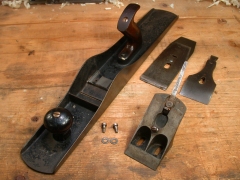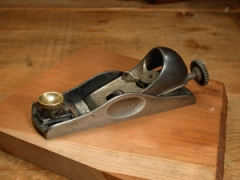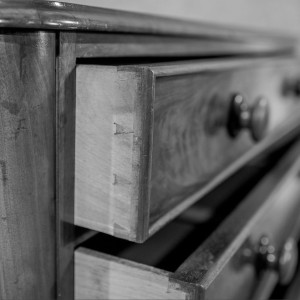
c. 1940s Stanley No. 5 Jack Plane
When I first started buying and collecting vintage hand planes, much of the available information I read online included ominous warnings about warped, twisted soles, unstable frogs, and mangled throats. Sounded more like a Stephen King movie than a discussion about tools! With recommendations for evaluation that involved engineering squares and feeler gauges. I was convinced that no vintage plane I purchased could ever possibly work correctly until I lapped the sole and re-machined every contact surface. It only took me suffering through flattening one or two planes to come to my senses and question just what the heck I was trying to accomplish.
Once I actually started sharpening, tuning, and using hand planes, I realized that most of these warnings were just a lot of unwarranted hooey. The vast majority of vintage planes I’ve owned and used over the years were actually just fine. Naturally, using a nice new Lie Nielsen or Veritas plane provides a noticeably different experience, but at a substantial cost premium. I’m just not there yet, and may never be. Here’s why…
The quality of the tool doesn’t contribute nearly as much to the end result as does the skill of the user. Craftsmen of 100 or so years ago made do just fine with the planes that were available. The average woodworker at the turn of the century didn’t own a micrometer or a machined straight edge. Many didn’t even use a measuring device, instead relying on dividers, marking gauges, and geometry. They used the tools and technology of the day, and produced some of the finest furniture in the world.
That’s not to say that tool quality isn’t important. Or more precisely, it’s not even so much the quality of the tool itself, but the quality of the tool’s tuning combined with proper technique that produces the desired result. As many others have pointed out before, a plane is really nothing more than a jig for holding a cutting implement at a consistent angle. With the appropriate ‘jig-o-metrics’ (tuning) applied, a properly sharpened cutting edge, and skillful application by the user, even the cheapest home center hand plane can competently get the job done. What quality of design, machining, and related workmanship gets you is ease of use and greater versatility. With tighter tolerances you get less slop and greater precision. While a high quality tool won’t improve the results of an unskilled user, it can certainly improve the results of one who has mastered its use.
All that said, there are some red flags to look for when shopping for hand planes, and with the abundance of vintage planes available on eBay, yard sales, and tool swaps across the country, there’s no reason to settle for a tool with serious problems. The challenge is knowing what is serious, and what isn’t. So let’s take it part by part. I’ll try to keep it simple.

Stanley No. 7, Lever Cap & Iron/Cap Iron
Body & Sole
Also sometimes referred to as the ‘base’ or ‘shoe,’ the body of the plane, as the name implies, is the main frame. The sole is the surface that comes in contact with the wood when using the plane. The main thing to look for on the body is cracks and/or repairs. Planes with this sort of damage are best avoided. Small chips along the top edges (cheeks) don’t affect usability, but are cosmetically undesirable. With so many planes available, why settle? The other thing to inspect on the body is the opening where the iron (blade) protrudes. It’s important that the opening, called the mouth or throat, isn’t chipped and hasn’t been repaired or enlarged through filing. The throat opening affects your ability to properly set the iron, and is one area of the plane where precision is extremely important.
Pitting is usually high on the list of problems to avoid. Again, with so many planes available, there’s no reason to settle for a tool with heavy pitting. Pitting is damage from rust that has eaten into the metal. In my experience, unless the pitting is very heavy, it doesn’t usually have much effect on a plane’s performance. Like all the normal scratches, scars, and dings from use that you’ll see, very light areas of pitting are not uncommon and are of little concern with regards to practical usability.
Some folks might disagree, but I don’t worry too much about the flatness of the sole. Having owned more than 250 vintage planes over the course of the time, I’ve only had a few that were unusable, and each of them had other issues more critical than the flatness of the bottom. Slap a ruler or straightedge against it if it makes you feel better or if you’re spending more than $75-$100 on a standard bench plane to use. However, if your need for critical tolerances is that great, I recommend you invest in a modern Lie-Nielsen or Veritas plane. They are machined to engineering grade tolerances, but you’ll pay a premium for them.
Knobs and Totes
The wooden knobs and totes (handle) on planes are frequently found with chips, cracks, and breaks. Aside from the obvious preference that they be perfect, minor damage is usually just cosmetic. Functionality is only compromised when the damage is so bad that they are unstable or inhibiting a proper grip on the plane. Breaks and cracks can often be repaired, even if the damage is severe, and replacements are abundant. If the tool is in otherwise good condition, a damaged or missing knob or tote isn’t a deal breaker for me. For more information check my post on repairing knobs and totes.

Stanley #7 Frog
Frog
The frog is the part of the plane that attaches to the top side of the base and provides an angled seat for the iron (blade), as well as a mechanism to adjust the depth and lateral positioning of the iron. I have no idea why it’s called a frog. Damage to look for is a missing lateral adjustment lever, which was a feature on the frogs of most Stanley (and other) bench planes manufactured after the mid 1880s. The lateral lever sticks up from the top of the frog and enables lateral (side to side) positioning of the iron. Every now and then this lever is missing. Ideally it should be straight and tight, although bends can be straightened and if it’s wobbly, it can be tightened by carefully tapping its rivet with a small ball peen hammer.
Broken and chipped frogs are the main concern and should be avoided. Look close at the bolt hole in the front center of the frog to make sure there are no chips around the edge. Once again, replacement frogs are fairly plentiful, but you will need to find one from the same period of manufacture to ensure proper fit since the design changed over the years.
Iron and Cap Iron
The iron, also referred to as the ‘cutter’ or ‘blade,’ is the tool’s cutting implement. The main things to look for are how much usable length remains and the condition of the surface metal. Pitted irons are not necessarily a lost cause (see my post on salvaging irons), but are problematic. Again, period irons are abundant, but if you’re buying the plane to use, you’ll want to invest in a modern replacement from somewhere like Hock, Lie-Nielsen, or Lee Valley Tools. They are far superior and will make a significant difference in the plane’s performance.
The cap iron, which is sometimes called the chipbreaker or double iron, attaches to the top of the iron and provides both stability and a raised surface to literally break the shaving as it’s cut from the wood. Other than very heavy pitting or a hack grinding job, I’ve rarely seen one of these that wasn’t usable.
Lever Cap
The lever cap sits on top of the iron/cap iron assembly and provides tension to hold them against the frog. Lever caps are sometimes found with chips along the bottom edge, either from having been dropped or used as a screwdriver to loosen the wide screw that attaches the iron and cap iron. While unsightly, a chip along the bottom edge doesn’t really affect its functionality. Again replacements are plentiful. Of greater concern is if it’s missing the tab lever at the top, which acts as a cam that locks the lever cap against the frog. It’s rare that this is missing, but the lever cap cannot function without it.

Frog Adjustment Hardware
Hardware
I’ve covered all the major functional parts, so all that remains is the miscellaneous hardware on the plane – screws, bolts, brass knob, etc. You will want to make sure all the parts are there in order for the plane to function, unless you’re willing to buy replacements on eBay. Since Stanley and others used a very unusual threading on their hardware, you won’t find replacements in your hardware store.
The knob and tote are attached to the plane with a bolt that is threaded on both ends, topped with a brass nut that is visible from the top. Models made during WWII may have single piece steel bolts.
The frog should have a bolt sticking out of the front of it that holds the iron/cap iron via the lever cap. The frog itself is attached to the base with two smaller bolts with washers. At the rear of the frog should be a large brass knob that is used to raise and lower the iron through the throat. It’s important that this knob turn freely across the full length of its bolt, although it’s not unusual to have to clean this area thoroughly before it will work as intended.
On Stanley bench planes made after 1907, there will be an adjustment bolt that engages a small plate attached to the bottom rear of the frog. This enables fine forward/backward adjustments to the frog, which has an effect similar to closing the throat of the plane for fine cuts. Since most bench planes did not have an adjustable throat as found on some of the better block planes, this frog adjustment allowed movement of the entire frog, which accomplished the same thing. Moving the frog back opens the throat for thicker cuts, while moving it forward closes the throat for very fine shavings. It’s actually pretty rare to find this feature permanently frozen due to rust and corrosion, but it’s something to look out for. While it may take a few days of soaking in penetrating oil, they almost always free up.
That’s pretty much it. Very few vintage hand planes are in perfect condition, so it’s important to have realistic expectations. Almost all show the effects of age and use. This is what gives them character. Perhaps most important for new buyers shopping for a first hand plane is to first understand how they function and how they are used. That will make evaluating condition much easier and the assessment more relevant. Additionally, all new hand plane purchasers need to understand that no tool they buy, whether 100 years old or manufactured yesterday, is going to function effectively without proper tuning. That discussion I will save for another post.
***
Tools shown in the photos were returned to functional condition by Virginia Toolworks using museum quality archival preservation techniques. Sharpened and tuned for use, every tool is fully tested and adjusted until perfect.
 At some point, almost certainly early in its life, the plane was dropped, breaking off the top quarter of the frog. In a classic reflection of those parsimonious times and testament to the care the owner gave to his tools, he went to unusual lengths to repair that frog, fabricating a perfectly fitting replacement section out of brass, secured with handmade copper rivets. Normally I shy away from tools with such repairs, but the complexity and care given to this one fascinated me. It was extremely well executed, having no doubt taken the better part of a day (perhaps even two) to complete, with an aesthetic effect that was detectable only upon close inspection. More important, it also returned the plane to perfect working order.
At some point, almost certainly early in its life, the plane was dropped, breaking off the top quarter of the frog. In a classic reflection of those parsimonious times and testament to the care the owner gave to his tools, he went to unusual lengths to repair that frog, fabricating a perfectly fitting replacement section out of brass, secured with handmade copper rivets. Normally I shy away from tools with such repairs, but the complexity and care given to this one fascinated me. It was extremely well executed, having no doubt taken the better part of a day (perhaps even two) to complete, with an aesthetic effect that was detectable only upon close inspection. More important, it also returned the plane to perfect working order. I was so conflicted I let the plane sit in my shop for weeks as I tried to decide what to do with it. Obviously treasured by its original owner, whether through necessity or nostalgia, it was used and handed down within his family for numerous generations. I hated to think of it being sold for scrap or parts after 130 years, especially given its impeccable working condition. Eventually reason and practicality prevailed, and I reluctantly decided to just list it at a fixed price on eBay, hoping I would find a buyer who could appreciate it as it was. And find a buyer I did… one with a surprising affinity for this particular plane.
I was so conflicted I let the plane sit in my shop for weeks as I tried to decide what to do with it. Obviously treasured by its original owner, whether through necessity or nostalgia, it was used and handed down within his family for numerous generations. I hated to think of it being sold for scrap or parts after 130 years, especially given its impeccable working condition. Eventually reason and practicality prevailed, and I reluctantly decided to just list it at a fixed price on eBay, hoping I would find a buyer who could appreciate it as it was. And find a buyer I did… one with a surprising affinity for this particular plane.







 Ever look closely at a really fine piece of vintage furniture in a historic building or museum? The vast majority, if viewed at a low angle across their flat panels, have a very subtle but distinct scalloped surface finish. This, of course, was due to the final shave with a smoothing plane – one with a slightly cambered edge.
Ever look closely at a really fine piece of vintage furniture in a historic building or museum? The vast majority, if viewed at a low angle across their flat panels, have a very subtle but distinct scalloped surface finish. This, of course, was due to the final shave with a smoothing plane – one with a slightly cambered edge.